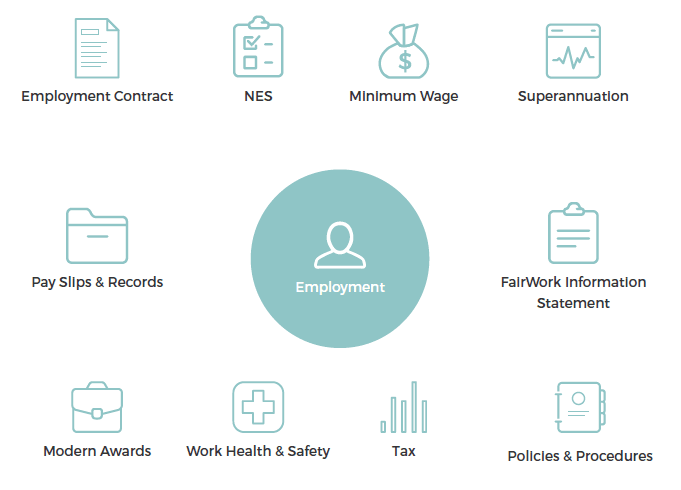
As your business grows, building your team is an exciting new stage! This is when you really start to feel like you’re growing, and open up new opportunities and perspectives within your business. Setting up your team with the right legals is setting your business up for success.
As you might have seen on the news with other businesses, non-compliance with employment law can be very damaging to your brand and have catastrophic consequences for the business. So it is very important that you are aware of your obligations as an employer.
Employees and contractors
There are two main ways to build your team – hiring employees or engaging contractors. There is an important conceptual difference between the two – an employee has a special status as part of the business, whereas a contractor runs their own business (i.e. they normally have their own ABN and may invoice you for their work).
Even if someone is called a contractor, if the relationship resembles an employment relationship in substance, then they are considered an employee under law and the relevant obligations apply. Many businesses try to treat employees as contractors – often to avoid paying minimum wage and superannuation – but this is called ‘sham contracting’ and heavy penalties for engaging in this behaviour, so don’t do it!
You can find out more about contractors and employees on the Australian government’s FairWork website.
Contractor Agreements
If you’re engaging contractors, you need a Contractor Agreement. A Contractor Agreement is very similar to a Service Agreement/ Business Terms & Conditions, discussed in Chapter 7. Key things to be clear about are – scope of the work, payment and dispute resolution.
Employment Contracts
It is essential that you enter into an Employment Contract with each of your employees. A good contract will cover important matters such as salary, leave, probation periods, ownership of intellectual property, confidentiality and termination rights. You may also want to include restraint and/or non-solicitation clauses, to restrict the ability of employees to leave and poach your customers and staff.
You can obtain a copy of casual, part-time and full time templates from FairWork. However these will not provide much in the way of business protection as they tend to be favourable to employees. Alternatively, you can speak to us about drafting an Employment Contract for your business.
Some other things that should be part of your Employment Contracts and procedures are outlined below.
Employment law – areas to consider
We’ve created the visual map which sets out the key areas of employment law for you to consider.

Types of employees
The three types of employees are casual, part-time and full-time. Employees receive different minimum entitlements depending on whether they are casual, part-time or full-time employees. In addition, some of these entitlements are only available once an employee has reached a certain minimum period of employment with the same employer. You should be aware of these minimum entitlements and ensure they are provided to the relevant employees.
For more details, have a read through these details on the FairWork website.
National Employment Standards (NES)
All employees in Australia are entitled to the 10 minimum conditions called the National Employment Standards or the NES, covering things like leave, flexible working practices, and annual leave requirements. You should be aware of these conditions and ensure that your business is compliant in the way you treat your employees.
Awards
In addition to the NES, employees may be covered by ‘modern awards’ – these are industry and occupation-specific minimum entitlements for individuals covered by the applicable modern award. Not all industries and occupations are covered by a modern award. If an award applies to your employees, you should be aware of any such additional standards and ensure that you are compliant with the award in your engagements with those employees
You can browse through the current awards and agreements here.
Minimum wage
Employees must be paid at least the minimum wage provided in their award or agreement. If they aren’t covered by an award or agreement, they must be paid at least the national minimum wage under the NES.
Minimum wages usually increase on 1 July every year. For help with pay rates see here.
Superannuation
Employers generally must pay a percentage of an employee’s income into their nominated superannuation fund. The current percentage is 9.5%.
However, there are exceptions for:
- individuals under 18 years who do not earn $450 or more (before tax) in a calendar month and work more than 30 hours in a week; or
- individuals over 18 years old who do not earn $450 or more (before tax) in a calendar month.
More information on this topic is available here.
Pay slips and records
Pay slips have to be given to an employee within 1 working day of pay day, even if an employee is on leave. You are required by law to keep certain written time and wage records for each employee. These records must be kept for at least seven years.
Visit here for information on what to include on pay slips, and here for detailed information about what records you need to keep.
Tax
As an employer, you need to meet tax obligations for all workers. In particular, you must determine the tax rate to withhold from payments you make to your employees so they can meet their taxation obligations. In order to collect tax payments from your employees, you will need to use the PAYG (Pay As You Go) withholding system.
You may also be liable to pay Fringe Benefits Tax (FBT). FBT is the tax you pay on fringe benefits you provide to employees, e.g. a company car, parking space or entertainment.
Some employers will also have to pay payroll tax when their total wages exceed a certain level called the ‘exemption threshold’.
Visit the ATO for more information. You should also speak to your tax advisor to make sure you are complying with your tax obligations.
Work Health and Safety (WHS)
As mentioned in Chapter 5, as an employer you are required by law to provide a healthy and safe working environment. You also need to pay worker’s compensation insurance for your employees.
Policies and procedures
It is a good idea to create a staff handbook for your business, setting out policies and procedures covering certain matters. In particular, there are laws governing workplace discrimination, sexual harassment and workplace bullying. Having a staff handbook containing robust policies can assist in promoting proper conduct in your workplace – and also provide you with recourse where your employees breach the policy.
FairWork has some useful guides about harassment, bullying and discrimination in the workplace.
Fair Work Information Statement
You must give every new employee a copy of the Fair Work Information Statement, before, or as soon as possible after, they start their new job.
In conclusion…
In this chapter we’ve learned about the legal steps required to build your business’ team. There are a lot of important legal requirements when hiring employees and contractors. Getting this right means both you and your team are protected, and you can work together to focus on the important stuff that makes your business tick. If you need advice preparing Contractor Agreements, Employment Contracts – or just understanding any of your employment law obligations – feel free to get in touch and we’d be happy to help you out.
Interested in working with us?
Tell us about your legal issue and we’ll put together a fixed fee quote for you.


 Previous
Previous